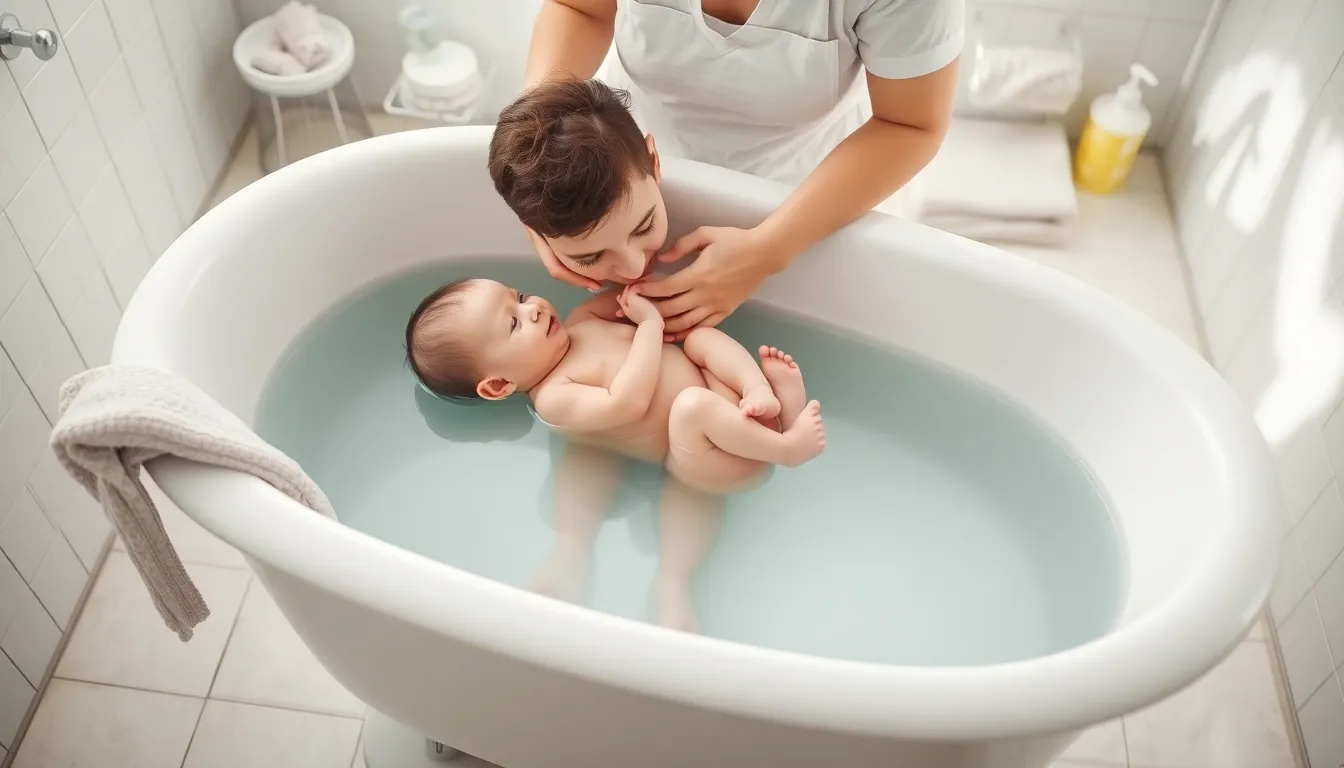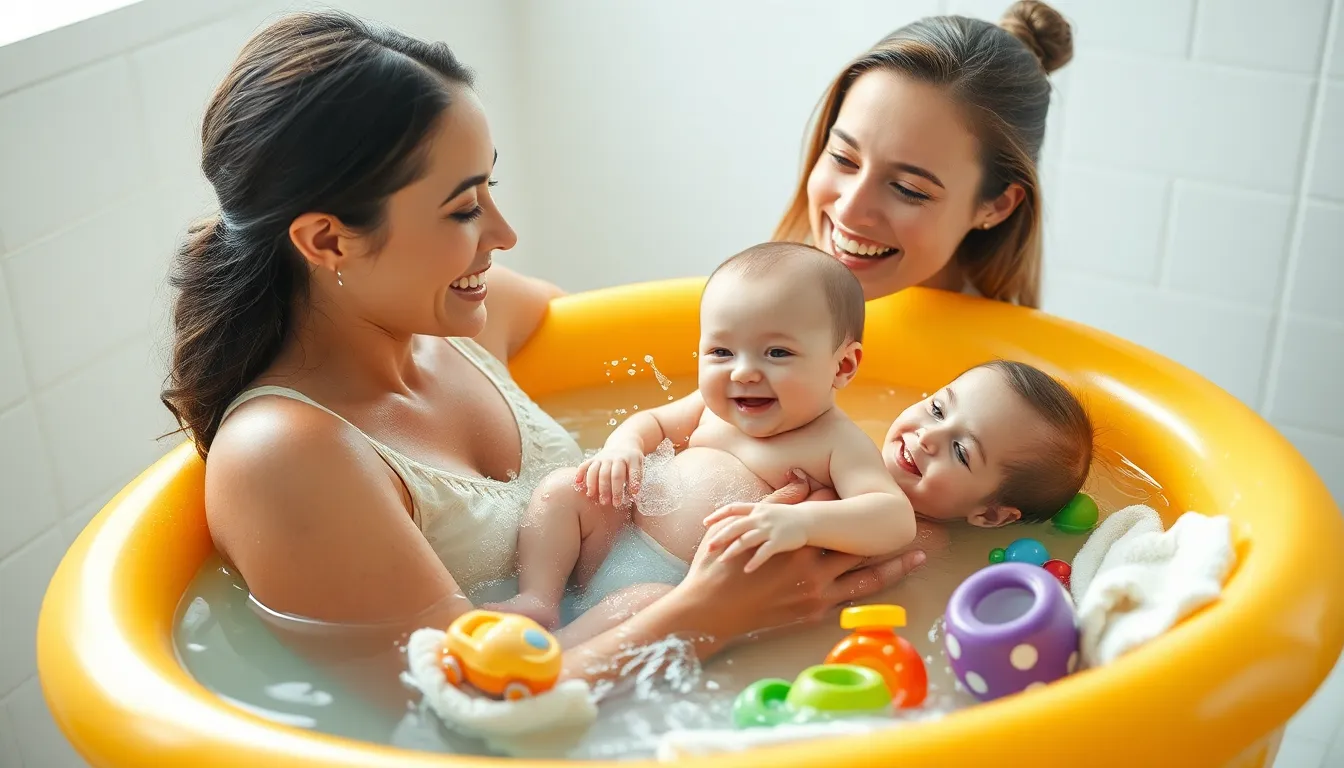Bath time for newborns can feel like a scene straight out of a comedy movie. Picture tiny toes splashing, slippery bodies wriggling, and a whole lot of giggles—both from the baby and the slightly panicked parents. But fear not! With the right baby bath, this daily ritual can transform from a chaotic splash zone into a serene bonding experience.
Table of Contents
ToggleOverview Of Baby Baths For Newborns
Newborn baths provide essential hygiene and comfort, making this routine valuable for both babies and parents. Various types of baby baths are available, each designed to ensure safety and convenience. Infant tub options include inflatable tubs, traditional bathtubs, and bath seats, catering to different preferences.
When choosing a baby bath, consider factors such as size, portability, and ease of cleaning. Proper support is crucial; some models feature contoured designs for optimal positioning. Materials used in construction should ensure both safety and durability, with options like plastic and foam commonly employed.
Temperature control remains vital during bath time. It’s important to maintain water at a comfortable 90 to 100 degrees Fahrenheit to avoid chilling or overheating the baby. Water depth should not exceed a few inches, reducing the risk of slipping or submerging the newborn.
Bathing frequency varies by caregiver and baby; many suggest bathing newborns three times a week. Overbathing can lead to dry skin, which parents should monitor closely. Bath time can also be an opportunity for sensory exploration. Gentle, age-appropriate shampoo and body wash products are preferable, devoid of harsh chemicals.
Enjoyable experiences during bath time often promote bonding. Interactive games and soft toys can enhance the bath routine, fostering a playful atmosphere. Approaching this daily task with patience and attentiveness makes a substantial difference for both the child and caregiver. Prioritizing safety and comfort ensures that bath time remains a joyful moment in the nurturing process.
Types Of Baby Baths

Parents can choose from various types of baby baths designed for safety and comfort. Each option offers unique features to accommodate different needs.
Traditional Bathtubs
Traditional bathtubs usually provide ample space for newborns. These tubs allow parents to bathe their babies using a supportive bathing cushion or a soft towel. Safety plays a crucial role, so ensure non-slip surfaces reduce the risk of accidents. Many traditional bathtubs feature temperature gauges to help maintain a comfortable water temperature. These bathtubs are great for families wanting to establish a routine in a designated area.
Infant Bathtubs
Infant bathtubs focus on portability and ease of use. Many are designed to fit in standard sinks, offering convenience for quick baths. Some infant bathtubs include reclining positions for optimal support. Lightweight materials make handling these baths easy, and many models feature removable components for easy cleaning. Choosing an infant bathtub can streamline the bathing process while ensuring a secure environment for newborns.
Sink Baths
Sink baths create an easy and accessible bathing experience. Parents can utilize kitchen or bathroom sinks for this type of bath. Using the sink enables caregivers to maintain eye contact and provide comfort. Water depths can be easily controlled, ensuring safety for the baby. Sink baths are particularly useful for tiny newborns, as they minimize effort while maximizing interaction.
Features To Consider
Selecting a baby bath requires an understanding of various features. Parents can create a safe and enjoyable bathing experience by considering safety, material quality, and portability.
Safety Features
Safety features are paramount when choosing a baby bath. Non-slip surfaces prevent accidental slips during bath time. Some models include sturdy supports to secure infants in place. Temperature gauges ensure water is neither too hot nor too cold. Parents should also look for baths with a solid base to avoid any tipping. Drain plugs enable easy water disposal, reducing the risk of slipping accidents.
Material Quality
Material quality impacts the overall safety and comfort of a baby bath. Choose a bath made from BPA-free plastic to avoid harmful chemicals. It’s important to pick materials that resist mold and bacteria growth, ensuring cleanliness. Soft fabrics or cushioning offer comfort and support for newborns. Consider baths with smooth edges to prevent any scratching. Durability is key; parents want a bath that lasts through multiple uses.
Size and Portability
Size and portability make a significant difference in usability. Compact designs fit well in standard sinks or small bathrooms. When traveling, lightweight options allow for easy transport and storage. Some baths offer collapsible features, maximizing convenience for parents. A bath that accommodates growth can extend its usefulness as the baby matures. Overall, selecting the right size ensures a comfortable bath experience for both parent and newborn.
Tips For Bathing Newborns
Bathing a newborn requires attention to detail to ensure safety and comfort. Proper preparation and techniques make this experience enjoyable for both parent and child.
Preparing The Bath Area
Choose a secure and comfortable location for bathing. A flat surface like a changing table or countertop can work well. Gather essential items including a baby bath, towels, washcloths, and gentle soap. Ensure warm water is ready, maintaining a temperature between 90 to 100 degrees Fahrenheit. Position the baby bath within arm’s reach to prevent stretching during the process. Check that all items are hygienic, keeping bath time safe and pleasant. Have everything ready to minimize distractions and refine the focus on bonding with the baby.
Bathing Techniques
Start by supporting the baby’s head and neck with one hand while using the other to gently wash. Use soft washcloths to clean the baby’s body. Keep the water shallow, ensuring it only covers the lower body, thus maintaining security and warmth. Talk to the baby, maintaining eye contact to encourage a comforting atmosphere. Avoid using products with fragrances or harsh chemicals to protect sensitive skin. After bathing, wrap the baby in a warm towel promptly to retain heat. Ensuring a smooth transition from bath to drying promotes a calming and enjoyable experience.
Bath time for newborns can transform into a delightful bonding experience when approached with the right tools and techniques. Choosing the appropriate baby bath not only enhances safety but also ensures comfort and ease for both parent and child. By focusing on essential features like portability and material quality, parents can make informed decisions that suit their lifestyles.
Creating a warm and engaging atmosphere during bath time fosters connection and promotes sensory exploration. With the right preparation and a little patience, this routine can become a cherished moment in a newborn’s daily life. Embracing the joy and laughter that comes with splashes can turn a simple bath into a memorable experience filled with love and care.



